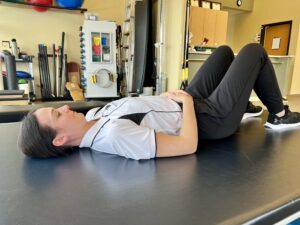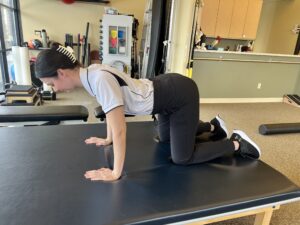Keeping your neck and spine healthy while you work
As physical therapists, we often see patients who experience neck and back pain related to their desk job. When we talk to patients in sessions about posture and positioning, we do it because it helps to reduce injury to your neck and spine. Think of your head as a bowling ball weighing on average, between 8-11 pounds. If we sit with a forward head or forward bent posture for hours each day, our back and neck have to work harder to support the head. This often results in pain. In this article, I will highlight a few exercises you can use to help prevent injury and promote good posture. Don’t let prolonged desk work cause you pain.
1. Wall “W” Trapezius strengthening
This exercise focuses on strengthening muscles in our mid back to help with the ability to hold and maintain posture.
To perform this exercise: Stand with your back against a wall or doorway. Engage your shoulder blade muscles to bring your scapula down and back, and then place your arms in a ‘W’ position with your elbows, wrists, and back of hands against the wall. Movement: From this position, move your arms up and down as if making a ‘snow angel’ while keeping everything in contact with the wall. Be sure to keep your head in a chin-tuck position.


2. Snow Angels on a foam roller
This exercise is excellent for anterior shoulder and chest flexibility. This will help you to maintain an upright posture.
To perform this exercise: Lie lengthwise on a foam roller so that the area from your low back/sacral area to your head is on the roller and the feet are flat on the floor with knees bent. Position the spine in neutral (do a pelvic tilt) and work to maintain a neutral spine while sliding your arms with palms up as far as you can until you feel a stretch through the front of your shoulder and chest area. Hold for 5 seconds and lower back to the starting position, repeat 10-15 times.


3. Supine Chin Tuck with Head Lift
This exercise focuses on strengthening smaller muscles around the cervical spine to help promote good posture and reduce strain through the surrounding musculature of the neck.
To perform this exercise: Begin by lying on your back with your head on a flat surface. Tuck your chin when you are in this position (I will tell patients oftentimes “try to give yourself a double chin.”) Once in this position, lift your head about a half inch off the floor/bed. Hold for 3-5 seconds and repeat 10-15 times. Important to note: Do not lose your chin tuck when lifting your head or when lowering it back down, only release it when your head is back to starting position.


4. Cat-Cow
This exercise is helpful for spinal mobility, and reducing muscle tension throughout the mid and low back.
To perform this exercise, begin on your hands and knees. Make sure your hands are below your shoulders and your knees are below your hips. Arch the upper portion of your back as much as you can while bringing your head toward your chest. Return to starting position, and immediately arch the lower portion of your spine so that your stomach comes toward the floor while simultaneously raising your head to a neutral or slightly extended position. Perform 10-20 repetitions slowly. This exercise can also be modified to be performed in standing or seated.


These exercises, together with an increased focus on improved posture at the workplace, can help reduce the risk of work-related injury and pain. If doing these exercises does not provide relief, working with a Physical Therapist at Freedom Physical Therapy Services can provide specific treatment to your symptoms.

